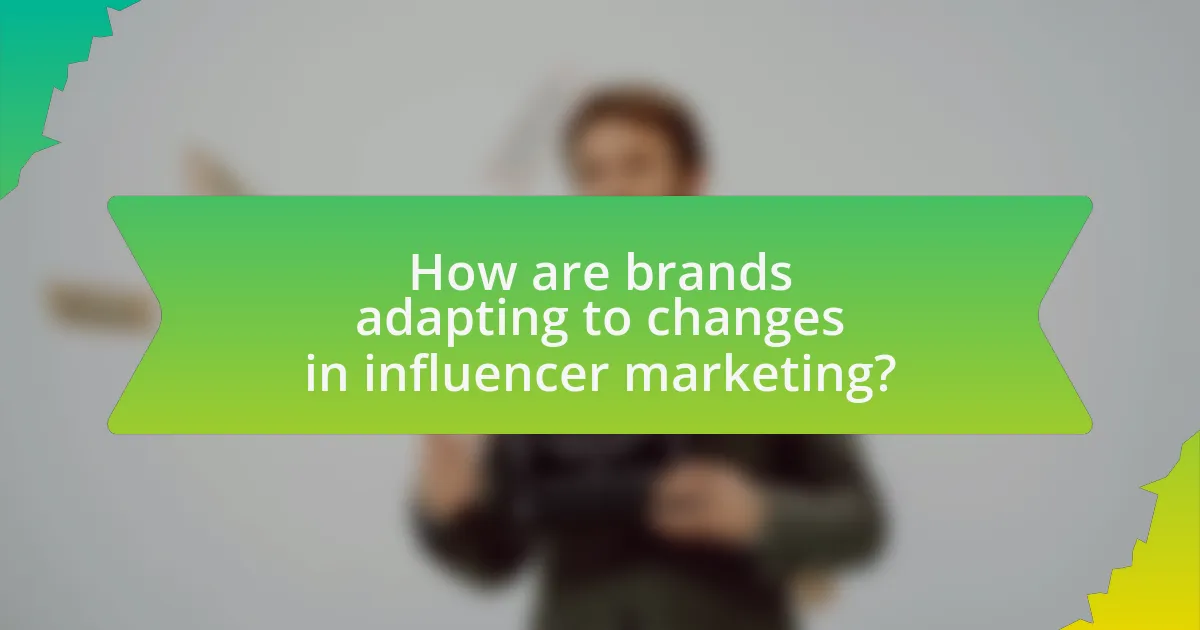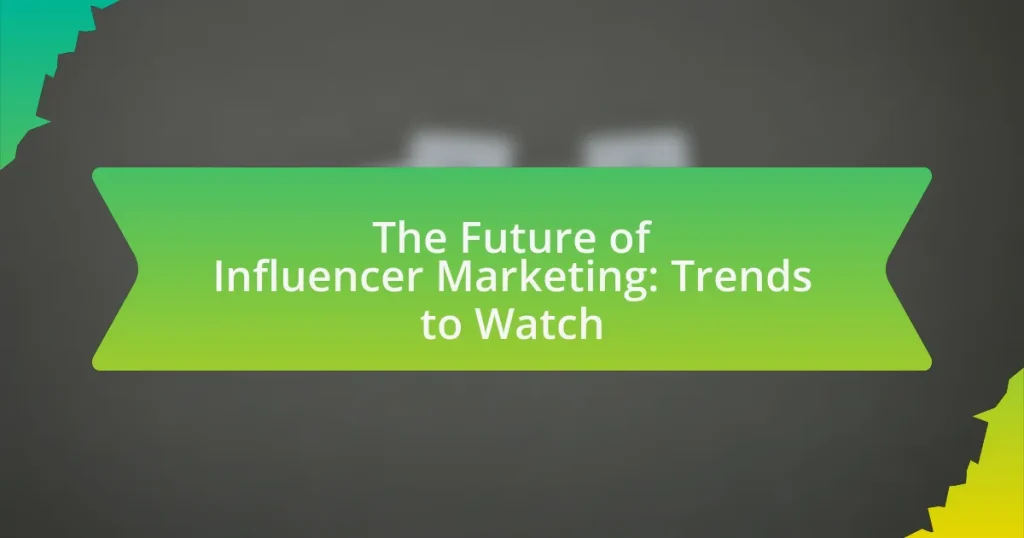The article focuses on the future of influencer marketing, highlighting key trends such as the increasing importance of authenticity, the rise of micro and nano influencers, and the integration of data-driven strategies. It discusses how technological advancements, including artificial intelligence and data analytics, are shaping marketing strategies and enhancing campaign effectiveness. Additionally, the article examines consumer behavior’s impact on influencer partnerships, the significance of compliance with advertising regulations, and best practices for brands to build long-term relationships with influencers. Overall, it provides a comprehensive overview of the evolving landscape of influencer marketing and its implications for brands and consumers.

What is the Future of Influencer Marketing?
The future of influencer marketing is expected to be characterized by increased authenticity, data-driven strategies, and the rise of micro and nano influencers. As consumers increasingly seek genuine connections, brands will prioritize partnerships with influencers who align closely with their values and audience. According to a 2022 report by Influencer Marketing Hub, 90% of marketers believe that influencer marketing is effective, and the industry is projected to reach $16.4 billion in 2022, indicating robust growth. Additionally, the use of advanced analytics will enable brands to measure campaign effectiveness more accurately, leading to more strategic influencer collaborations.
How is influencer marketing evolving in the digital landscape?
Influencer marketing is evolving in the digital landscape by increasingly integrating advanced technologies such as artificial intelligence and data analytics to enhance targeting and engagement. Brands are now leveraging AI tools to identify the most effective influencers based on audience demographics and engagement metrics, leading to more personalized marketing strategies. According to a report by Influencer Marketing Hub, 63% of marketers plan to increase their influencer marketing budgets in the coming years, reflecting a shift towards long-term partnerships rather than one-off campaigns. This evolution is also characterized by the rise of micro and nano influencers, who often yield higher engagement rates due to their perceived authenticity and niche audiences.
What technological advancements are shaping influencer marketing?
Technological advancements such as artificial intelligence, data analytics, and augmented reality are significantly shaping influencer marketing. Artificial intelligence enables brands to identify the most suitable influencers through algorithms that analyze audience engagement and demographics, enhancing targeting efficiency. Data analytics provides insights into campaign performance, allowing marketers to optimize strategies based on real-time feedback and consumer behavior patterns. Augmented reality enhances user engagement by allowing influencers to create immersive experiences, thereby increasing brand interaction and consumer interest. These advancements collectively drive more effective and measurable influencer marketing campaigns.
How do consumer behaviors influence the future of influencer marketing?
Consumer behaviors significantly influence the future of influencer marketing by shaping the types of content that resonate with audiences and determining the effectiveness of influencer partnerships. As consumers increasingly prioritize authenticity and relatability, brands are compelled to collaborate with influencers who genuinely align with their values and lifestyles. For instance, a 2022 survey by the Digital Marketing Institute found that 61% of consumers trust influencers more than traditional celebrities, indicating a shift towards valuing personal connections over celebrity endorsements. This trend suggests that brands will need to adapt their strategies to focus on micro and nano influencers, who often have higher engagement rates and foster stronger community ties. Consequently, understanding consumer preferences and behaviors will be crucial for brands aiming to leverage influencer marketing effectively in the evolving digital landscape.
What are the key trends to watch in influencer marketing?
Key trends to watch in influencer marketing include the rise of micro and nano influencers, increased focus on authenticity, and the integration of artificial intelligence in campaign strategies. Micro and nano influencers, who typically have smaller but highly engaged audiences, are becoming more valuable as brands seek genuine connections with consumers. A study by Influencer Marketing Hub in 2022 found that campaigns with micro influencers can yield up to 60% higher engagement rates compared to those with larger influencers. Additionally, brands are prioritizing authenticity, as consumers increasingly prefer influencers who share relatable content and personal stories. Finally, the use of artificial intelligence is growing, with tools that analyze audience data and optimize influencer selection, enhancing campaign effectiveness.
How is the rise of micro and nano influencers impacting marketing strategies?
The rise of micro and nano influencers is significantly impacting marketing strategies by shifting focus towards authenticity and niche engagement. Brands are increasingly leveraging these influencers due to their higher engagement rates, which can be up to 60% higher than those of macro influencers, according to a study by Markerly. This shift allows companies to target specific audiences more effectively, as micro and nano influencers often have dedicated follower bases that trust their recommendations. Consequently, marketing strategies are evolving to prioritize collaborations with these influencers, emphasizing genuine connections over sheer follower counts, ultimately leading to more effective and cost-efficient campaigns.
What role does authenticity play in the future of influencer marketing?
Authenticity is crucial in the future of influencer marketing as it directly influences consumer trust and engagement. Research indicates that 86% of consumers consider authenticity important when deciding which brands to support, highlighting that influencers who present genuine content foster stronger connections with their audience. This trend is expected to grow, as brands increasingly prioritize partnerships with influencers who demonstrate transparency and relatability, thereby enhancing brand loyalty and driving sales.
Why is data analytics important for influencer marketing?
Data analytics is crucial for influencer marketing because it enables brands to measure the effectiveness of their campaigns and optimize their strategies. By analyzing data such as engagement rates, audience demographics, and conversion metrics, marketers can identify which influencers resonate most with their target audience. For instance, a study by Influencer Marketing Hub found that businesses earn an average of $5.78 for every dollar spent on influencer marketing, highlighting the importance of data-driven decisions to maximize return on investment. This analytical approach allows brands to refine their influencer partnerships and improve overall campaign performance.
How can brands leverage data to select the right influencers?
Brands can leverage data to select the right influencers by analyzing audience demographics, engagement metrics, and content relevance. By utilizing tools that provide insights into an influencer’s follower base, brands can ensure alignment with their target market, as 70% of consumers are more likely to purchase from brands endorsed by influencers they trust. Additionally, engagement rates, such as likes, comments, and shares, serve as indicators of an influencer’s effectiveness, with a study showing that influencers with higher engagement rates can drive up to 10 times more conversions than those with lower rates. Furthermore, brands can assess content performance through analytics to identify influencers whose messaging resonates with their audience, ensuring a more impactful partnership.
What metrics should brands focus on to measure influencer marketing success?
Brands should focus on engagement rate, reach, and conversion rate to measure influencer marketing success. Engagement rate indicates how actively the audience interacts with the content, which is crucial for assessing the effectiveness of the influencer’s reach. Reach measures the total number of unique users who see the content, providing insight into brand visibility. Conversion rate tracks the percentage of users who take a desired action, such as making a purchase or signing up for a newsletter, directly linked to the influencer’s campaign. According to a study by Influencer Marketing Hub, campaigns with higher engagement rates typically see a 3-5 times better return on investment compared to those with lower engagement, reinforcing the importance of these metrics in evaluating influencer marketing effectiveness.

How are brands adapting to changes in influencer marketing?
Brands are adapting to changes in influencer marketing by shifting their focus towards authenticity and long-term partnerships with influencers. This adaptation is driven by consumer demand for genuine content, as studies show that 86% of consumers prefer authentic brand interactions. Additionally, brands are increasingly leveraging data analytics to identify the right influencers who align with their values and target audience, ensuring more effective campaigns. This strategic approach not only enhances engagement but also builds trust, as evidenced by the fact that 70% of consumers are more likely to purchase from brands that collaborate with influencers they follow.
What strategies are brands implementing to stay relevant?
Brands are implementing strategies such as leveraging data analytics, engaging in authentic influencer partnerships, and focusing on sustainability to stay relevant. By utilizing data analytics, brands can better understand consumer preferences and tailor their marketing efforts accordingly, which is crucial in a rapidly changing market. Authentic influencer partnerships allow brands to connect with audiences in a more genuine way, fostering trust and loyalty. Additionally, a growing emphasis on sustainability aligns brands with consumer values, as studies show that 66% of global consumers are willing to pay more for sustainable brands. These strategies collectively enhance brand relevance in an evolving landscape.
How are brands integrating influencer marketing into their overall marketing strategy?
Brands are integrating influencer marketing into their overall marketing strategy by leveraging social media platforms to enhance brand visibility and engagement. This integration often involves collaborating with influencers who align with the brand’s values and target audience, thereby creating authentic content that resonates with consumers. For instance, a study by the Digital Marketing Institute found that 49% of consumers depend on influencer recommendations, highlighting the effectiveness of this approach in driving purchasing decisions. Additionally, brands are utilizing data analytics to measure the impact of influencer campaigns, allowing for real-time adjustments and optimization of marketing efforts. This strategic alignment not only amplifies brand messaging but also fosters community engagement and loyalty among consumers.
What challenges do brands face in influencer marketing today?
Brands face several challenges in influencer marketing today, including authenticity issues, regulatory compliance, and measuring ROI. Authenticity is crucial as consumers increasingly demand genuine content; a study by the Digital Marketing Institute found that 86% of consumers consider authenticity important when deciding which brands to support. Regulatory compliance poses a challenge due to evolving guidelines from organizations like the Federal Trade Commission, which require clear disclosures of paid partnerships. Additionally, measuring ROI remains complex, with 49% of marketers citing difficulty in quantifying the effectiveness of influencer campaigns, according to a survey by Influencer Marketing Hub. These challenges necessitate strategic approaches to ensure successful influencer marketing initiatives.
How is influencer marketing being regulated?
Influencer marketing is being regulated through guidelines established by various governmental and industry bodies to ensure transparency and consumer protection. In the United States, the Federal Trade Commission (FTC) mandates that influencers disclose any material connections with brands, such as paid partnerships or free products, to prevent misleading advertising. This regulation is supported by the FTC’s enforcement actions and guidelines, which emphasize the importance of clear and conspicuous disclosures in social media posts. Similarly, in the European Union, the Audiovisual Media Services Directive requires influencers to label sponsored content, reinforcing the need for transparency in advertising practices. These regulations aim to maintain trust between consumers and brands while promoting ethical marketing practices.
What are the current regulations affecting influencer marketing practices?
Current regulations affecting influencer marketing practices primarily include guidelines set by the Federal Trade Commission (FTC) in the United States, which require influencers to disclose any material connections with brands. This means that influencers must clearly indicate when they are being compensated for promoting products or services, typically through hashtags like #ad or #sponsored. Additionally, the European Union has implemented the Audiovisual Media Services Directive, which mandates similar transparency in advertising across member states. These regulations aim to protect consumers from misleading advertising and ensure that influencers maintain ethical standards in their promotional activities.
How can brands ensure compliance with advertising standards?
Brands can ensure compliance with advertising standards by implementing clear guidelines and regular training for their marketing teams. Establishing a comprehensive understanding of relevant regulations, such as the Federal Trade Commission (FTC) guidelines in the United States, is crucial for brands to avoid misleading claims and ensure transparency in their advertising practices. Regular audits of advertising content and collaboration with legal experts can further reinforce adherence to these standards, minimizing the risk of penalties or reputational damage.

What are the future implications of influencer marketing?
The future implications of influencer marketing include increased reliance on data analytics for targeting and measuring campaign effectiveness. As brands seek to optimize their marketing strategies, they will increasingly utilize advanced analytics tools to assess influencer performance and audience engagement metrics. According to a report by Influencer Marketing Hub, 63% of marketers plan to increase their influencer marketing budgets in the coming years, indicating a shift towards more data-driven decision-making. This trend will likely lead to more personalized and effective marketing campaigns, as brands leverage insights to connect with their target audiences more efficiently.
How will influencer marketing impact consumer trust and brand loyalty?
Influencer marketing will significantly enhance consumer trust and brand loyalty by leveraging the authenticity and relatability of influencers. Research indicates that 70% of teenagers trust influencers more than traditional celebrities, which demonstrates the strong connection influencers have with their audience. This trust translates into higher engagement rates and a greater likelihood of consumers choosing brands endorsed by influencers they admire. Furthermore, a study by the Digital Marketing Institute found that 49% of consumers depend on influencer recommendations when making purchasing decisions, highlighting the direct impact of influencer marketing on consumer behavior and brand loyalty.
What are the potential risks associated with influencer marketing?
The potential risks associated with influencer marketing include lack of authenticity, regulatory compliance issues, and potential damage to brand reputation. Lack of authenticity arises when influencers promote products that do not align with their personal brand, leading to distrust among followers. Regulatory compliance issues can occur if influencers fail to disclose paid partnerships, resulting in legal repercussions for both the influencer and the brand, as highlighted by the Federal Trade Commission’s guidelines. Additionally, negative behavior or controversies involving influencers can lead to significant backlash against the brands they represent, as seen in cases where influencers faced public scrutiny, impacting brand perception and sales.
How can brands mitigate these risks effectively?
Brands can mitigate risks in influencer marketing effectively by implementing thorough vetting processes for influencers, establishing clear contracts, and maintaining open communication. Vetting influencers involves assessing their audience demographics, engagement rates, and past collaborations to ensure alignment with brand values. Clear contracts outline expectations, deliverables, and consequences for non-compliance, reducing misunderstandings. Open communication fosters transparency, allowing brands to address potential issues proactively. According to a study by the Digital Marketing Institute, brands that engage in comprehensive influencer vetting experience 30% fewer campaign-related issues, demonstrating the effectiveness of these strategies.
What best practices should brands follow in influencer marketing?
Brands should prioritize authenticity, audience alignment, and measurable outcomes in influencer marketing. Authenticity ensures that influencers genuinely connect with their audience, which enhances trust and engagement; studies show that 92% of consumers trust recommendations from individuals over brands. Audience alignment involves selecting influencers whose followers match the brand’s target demographic, increasing the likelihood of effective communication and conversion. Lastly, measurable outcomes, such as tracking engagement rates and return on investment, allow brands to assess the effectiveness of their campaigns, with 70% of marketers stating that measuring ROI is crucial for future strategies.
How can brands build long-term relationships with influencers?
Brands can build long-term relationships with influencers by fostering genuine partnerships based on mutual trust and shared values. Establishing clear communication channels and providing consistent support allows brands to align their goals with those of the influencers, creating a collaborative environment. Research indicates that 70% of marketers believe that influencer partnerships are more effective when they are authentic and transparent, which reinforces the importance of maintaining open dialogue and respecting the influencer’s creative freedom. By investing in ongoing collaborations, brands can cultivate loyalty and ensure that influencers remain engaged advocates over time.
What are the key elements of a successful influencer marketing campaign?
The key elements of a successful influencer marketing campaign include selecting the right influencers, establishing clear goals, creating authentic content, and measuring performance. Selecting the right influencers ensures alignment with the brand’s values and target audience, which is crucial for engagement; for instance, a study by Influencer Marketing Hub found that 63% of consumers trust influencers more than brands. Establishing clear goals, such as increasing brand awareness or driving sales, provides direction and helps in evaluating success. Creating authentic content that resonates with the influencer’s audience fosters trust and encourages engagement, as 86% of consumers say authenticity is important when deciding what brands to support. Finally, measuring performance through metrics like engagement rates and ROI allows brands to assess the effectiveness of the campaign and make data-driven adjustments.


